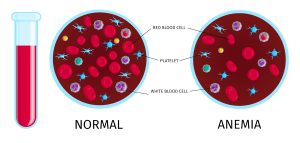Disclaimer:
This article is for information purposes only. It is not a substitute for medical advice or treatment. Seek medical care for your treatment.
Hemolytic anemia:
Red blood cells break down faster than they can be created in hemolytic anemia. The term hemolysis refers to the destruction of red blood cells.
All of your body’s parts get oxygen from red blood cells. Anemia is the condition when your red blood cell count is below normal. Your blood cannot supply all of your tissues and organs with ample oxygen when you have anemia. Your body cannot work as well as it should if it is not getting sufficient oxygen.
Causes and symptoms of hemolytic anemia:
There are several causes of hemolytic anemia. Hemolytic anemia can be due to acquired or inherited causes.
- Inherited hemolytic anemia: occurs when parents pass the gene to their children.
- Acquired hemolytic anemia: is not that you are born with it. You may develop it later.
Symptoms of hemolytic anemia vary from person to person. Some of the symptoms are mentioned below:
- Pale skin
- Jaundice
- Fever
- Dizziness
- Confusion
- Enlarged spleen or liver
- Headaches
- Increased heart rate
How is hemolytic anemia diagnosed?
Hemolytic anemia diagnosis starts with an evaluation of your medical and family history, physical exam, tests and symptoms. Your health care provider will be examining you for pale or yellow skin during your physical examination. He may examine your abdomen tenderness by mildly pressing on different areas of your abdomen which could specify an enlarged liver or spleen.
Doctor diagnose hemolytic anemia by:
- Performing a physical examination based on anemia signs and symptoms
- Inquiring about consuming cerastin medicines or if you have certain infections that may lead to hemolytic anemia
- Questioning about your medical and family history, particularly if any of your family members have anemia
What tests are done by your doctor to diagnose hemolytic anemia?
To diagnose hemolytic anemia your doctor may recommend several blood tests. He may examine blood tests for genetic markers. They will do initial blood tests to identify if your symptoms are caused by some form of anemia. A complete blood count (CBC) is one of the initial tests they may do. A CBC measures:
- How many white blood cells, red blood cells and platelets you have.
- Hemoglobin
- Hematocrit
- The size of your red blood cells
Your doctor may suggest the following tests:
- CBC: this test measures different parts of your blood
- Bone marrow: tests to inspect that the bone marrow is healthy and generating RBCs typically
- Other blood tests: if your CBC test indicates that you have anemia, then certain other tests can be done. Tests can determine the type and severity of anemia you may have
- Urine test: to check for blood in the urine
Some of the additional tests that your doctor may perform:
Your doctor may suggest following tests to determine the kind of anemia or hemolytic anemia you may have:
- Reticulocyte count: evaluate the number of immature red blood cells in your bone marrow. Doctor measure reticulocytes to discover if your bone marrow is producing sufficient red blood cells.
- Coombs test: this test look over for autoimmune hemolytic anemia.
- Lactate dehydrogenase: is an enzyme in red blood cells. A great LDH level indicates great red blood cell destruction.
- Unconjugated bilirubin: when your red blood cells collapse, they create bilirubin. This test evaluates the amount of bilirubin that is not being processed by your liver. This unconjugated bilirubin. High unconjugated bilirubin level indicates that huge numbers of red blood cells are being harmed.
- Peripheral blood smear: doctors examine blood cells for signs of abnormalities encompassing size and shape.
- Haptoglobin test: haptoglobin is a protein that terminates debris produced by ruinous red blood cells. Low haptoglobin levels indicate damaged red cells.
- Hemoglobin electrophoresis: through this test, healthcare providers analyze hemoglobin, a protein in your red blood cells that helps cells carry oxygen throughout your body.
- Testing for paroxysmal nocturnal hemoglobinuria: in PNH, the red blood cells are missing some proteins. The test for PNH can identify red blood cells that are missing these proteins.
- Osmotic fragility test: this test looks for red blood cells that are more sensitive than normal. These cells can be the sign of hereditary spherocytosis.
- Testing for glucose-6-phosphate dehydrogenase deficiency: in G6PD deficiency the red blood cells are lacking a significant enzyme called G6PD.
Conclusion:
Hemolytic anemia is the result of the breakdown of your red blood cells. This condition is an indication that you may have an inherited medical condition or a medical issue caused by infection. You might be responding to a certain drug. Your healthcare professional will concentrate on identifying and treating the underlying reason, regardless of the cause. Early detection frequently identifies whether a patient will get better or worsen. The symptoms of hemolytic anemia can resemble those of less severe illnesses. If you see changes in your body that don’t go away, consult your healthcare professional.




